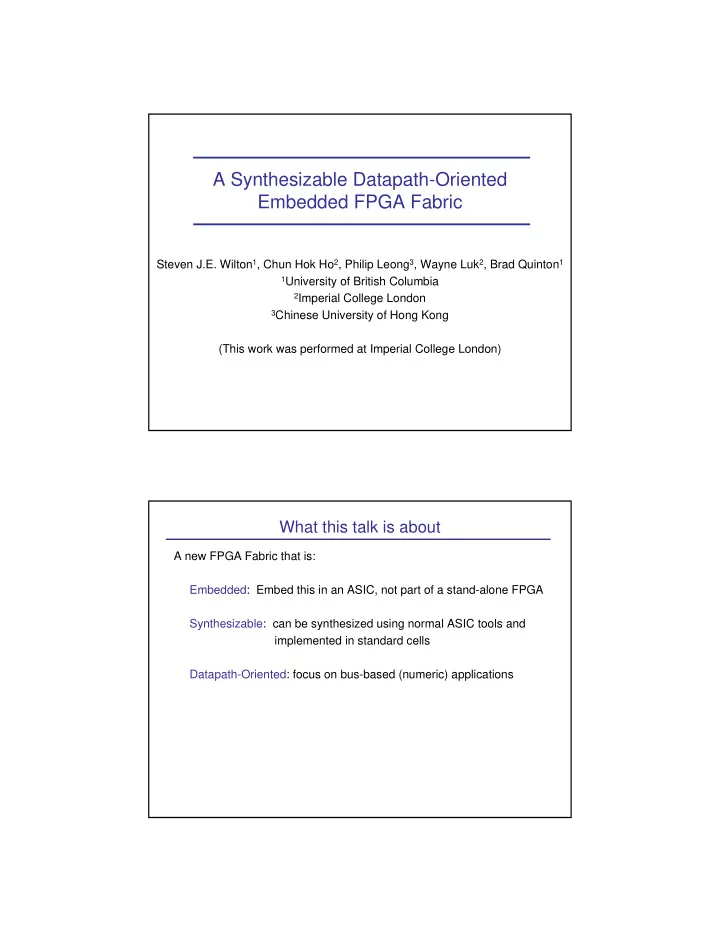

A Synthesizable Datapath-Oriented Embedded FPGA Fabric Steven J.E. Wilton 1 , Chun Hok Ho 2 , Philip Leong 3 , Wayne Luk 2 , Brad Quinton 1 1 University of British Columbia 2 Imperial College London 3 Chinese University of Hong Kong (This work was performed at Imperial College London) What this talk is about A new FPGA Fabric that is: Embedded: Embed this in an ASIC, not part of a stand-alone FPGA Synthesizable: can be synthesized using normal ASIC tools and implemented in standard cells Datapath-Oriented: focus on bus-based (numeric) applications
Motivation: Embedded Debug Embed a small amount of programmable logic onto an ASIC – Use this logic to observe and/or control internal signals – Perform simple data collection/monitoring operations This talk: Architecture of this block Synthesizable “Soft” FPGA Cores
Implications of Being Synthesizable Observation 1: To make it truly synthesizable, must avoid combinational loops in the unprogrammed fabric Observation 2: Each tile need not be identical Implications of being datapath-oriented: Use it when the PLC is connected to a bus: Bus Bus Observation: These connections are permanently tied to the bus signals, and we know this when the ASIC is designed
Logic Architecture Key point: - All bitblocks within a wordblock share same set of configuration bits - Means all bitblocks implement the same function Routing Architecture Key point: Signals are routed as buses
Routing Architecture Key point: - Linear array of wordblocks - Number of buses goes up as we go to the right Datapath Architecture SHIFT SHIFT SHIFT
Multipliers SHIFT SHIFT Two inputs instead of three Two output buses (MSB, LSB) Add a Control Block Status Mux Control Mux Control Block control status control status control status bit 0 bit 0 bit 0 bit 1 bit 1 bit 1 shifter shifter shifter bit 2 bit 2 bit 2 bit N-1 bit N-1 bit N-1 Output Mux Wordblock 0 Wordblock 1 Wordblock D-1 Input Buses (M) Output Buses (R) Constant Feedback Feedback Registers Registers (F) Mux (C) Q D status control Control block is based on P-term fine-grained synthesizable core
Example Mapping Monitor two buses: - Count the number of times each bus matches a mask - includes don’t care bits - Count the number of times Control Block both buses match the mask at the same time MASK MASK ADD ADD ADD reset input bus input bus constant output buses constant feedback feedback feedback Q D Interesting Questions: 1. How do the various architectural parameters affect density? 2. How does this compare to a fine-grained architecture?
Bench- Datapath Fined-Grain ASIC Fine-Grain/ Datapath/ Mark (ours) (PTerm) Datapath ASIC fbly 332,091 132,339,335 9,300 399 35.7 dotv3 225,518 65,534,780 6,575 291 34.3 dscg 325,029 116,271,968 9,473 358 34.3 fir4 307,154 130,971,120 9,843 426 31.2 egcd 3,778,611 22,776,474 10,420 6.02 363 momul 486,654 11,448,589 7,097 23.5 68.5 median 194,654 10,733,962 4,420 55.1 44 debug1 119,286 1,302,928 3,484 10.9 34 Key result 1: Significantly better than fine-grained architecture Key result 2: Overhead roughly the same as FPGA/ASIC 625 µ m 625 µ m
Conclusions Our architecture is 6 to 426 x more efficient than fine-grained architecture But, this is only for datapath-oriented circuits. However, this is ok: - In an SoC, we know, when the chip is designed, whether the inputs are buses or bits - If there are buses, use this architecture - If there are not buses, use a fine-grained architecture Final thought: using this architecture, the overhead is similar to that of a normal FPGA. People already accept this!
Recommend
More recommend